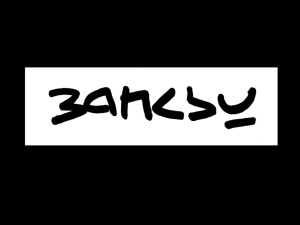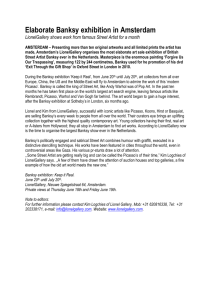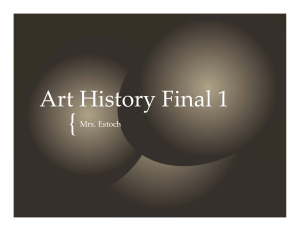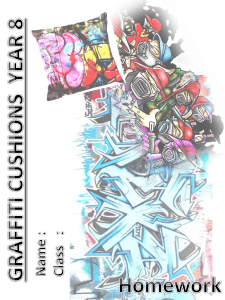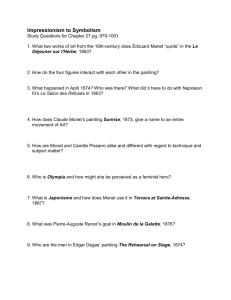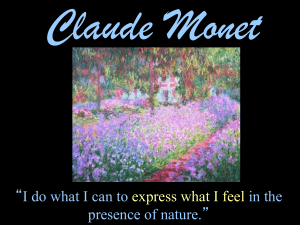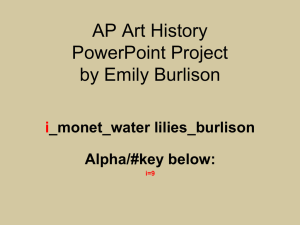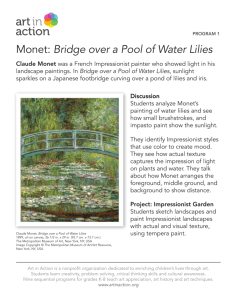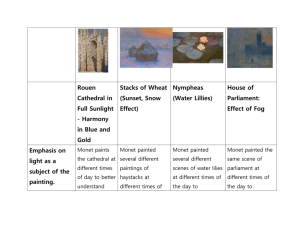Bansky correction
advertisement
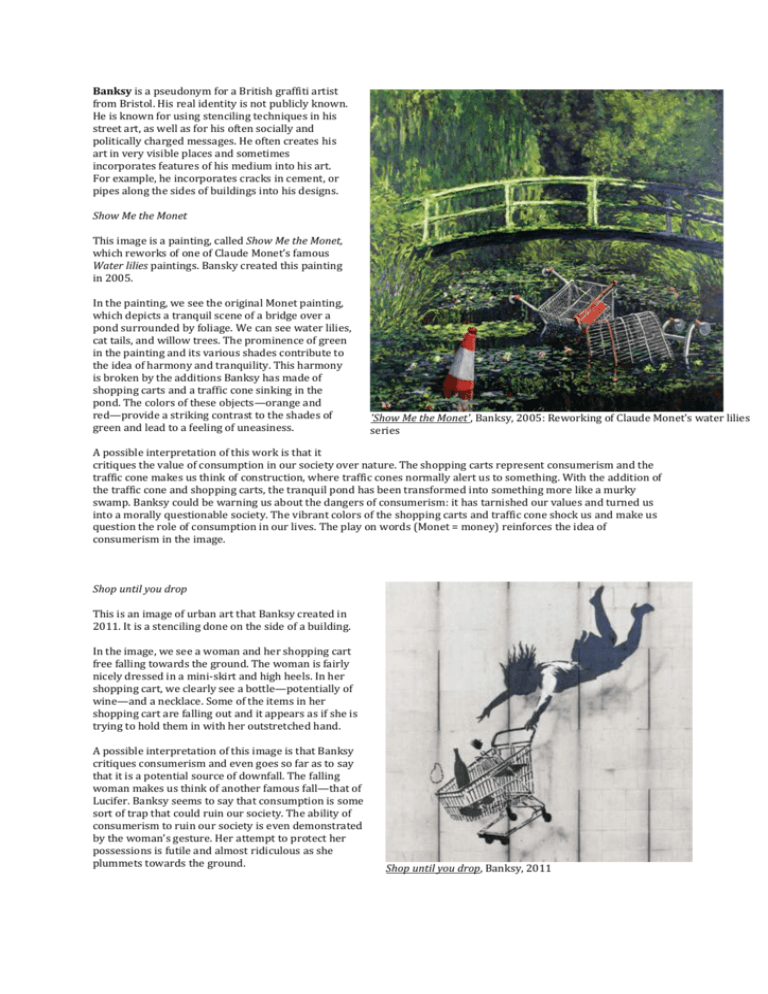
Banksy is a pseudonym for a British graffiti artist from Bristol. His real identity is not publicly known. He is known for using stenciling techniques in his street art, as well as for his often socially and politically charged messages. He often creates his art in very visible places and sometimes incorporates features of his medium into his art. For example, he incorporates cracks in cement, or pipes along the sides of buildings into his designs. Show Me the Monet This image is a painting, called Show Me the Monet, which reworks of one of Claude Monet’s famous Water lilies paintings. Bansky created this painting in 2005. In the painting, we see the original Monet painting, which depicts a tranquil scene of a bridge over a pond surrounded by foliage. We can see water lilies, cat tails, and willow trees. The prominence of green in the painting and its various shades contribute to the idea of harmony and tranquility. This harmony is broken by the additions Banksy has made of shopping carts and a traffic cone sinking in the pond. The colors of these objects—orange and red—provide a striking contrast to the shades of green and lead to a feeling of uneasiness. 'Show Me the Monet', Banksy, 2005: Reworking of Claude Monet's water lilies series A possible interpretation of this work is that it critiques the value of consumption in our society over nature. The shopping carts represent consumerism and the traffic cone makes us think of construction, where traffic cones normally alert us to something. With the addition of the traffic cone and shopping carts, the tranquil pond has been transformed into something more like a murky swamp. Banksy could be warning us about the dangers of consumerism: it has tarnished our values and turned us into a morally questionable society. The vibrant colors of the shopping carts and traffic cone shock us and make us question the role of consumption in our lives. The play on words (Monet = money) reinforces the idea of consumerism in the image. Shop until you drop This is an image of urban art that Banksy created in 2011. It is a stenciling done on the side of a building. In the image, we see a woman and her shopping cart free falling towards the ground. The woman is fairly nicely dressed in a mini-skirt and high heels. In her shopping cart, we clearly see a bottle—potentially of wine—and a necklace. Some of the items in her shopping cart are falling out and it appears as if she is trying to hold them in with her outstretched hand. A possible interpretation of this image is that Banksy critiques consumerism and even goes so far as to say that it is a potential source of downfall. The falling woman makes us think of another famous fall—that of Lucifer. Banksy seems to say that consumption is some sort of trap that could ruin our society. The ability of consumerism to ruin our society is even demonstrated by the woman’s gesture. Her attempt to protect her possessions is futile and almost ridiculous as she plummets towards the ground. Shop until you drop, Banksy, 2011 This document is a painting, I think it has been made using a stencil. The artist is Banksy, a British graffiti artist. The picture is one of the most recognizable images in popular culture – Jesus on the cross;except he is holding bags of gifts. The aim of the document is to mock the commercialisation of religious celebrations like Christmas, but more importantly to show the hypocritical relationship between the capitalist consumer culture and religious values. The artist also seeks to criticise Christians who contradict their own values by being greedy and overconsuming, companies who exploit religion in order to make money, and people in general who use serious religious holidays as an excuse to consume. When most people think of Christmas or Easter, they think about eating lots of food, spending lots of money, and receiving gifts. However, I’m not sure people realise that this is actually quite a recent invention. 100 years ago, Christmas was a more strict religious time. I think the artist is trying to show how our values have changed – before, religion was very important, but now religious celebrations have become an excuse for people to be greedy and selfish. This is especially ironic given that the Christian faith tells us that being selfless and giving to those in need is very important. Obviously this is a very controversial image, and would probably shock a lot of people. However, images of Christ are used all the time in order to make money – by jewellery companies and companies that make Christmas cards for example. If it’s ok to buy a Christmas card with a picture of the baby Jesus on it, or a necklace showing Christ on the cross, then I don’t think we can really say that this painting is morally wrong. If people accept the mix of business with religion, then why shouldn’t other people be free to denounce it? This image also makes me wonder whether or not it is always necessary to shock people in order to make them think about the world around them. Sometimes I think it is necessary to remind people of the truth using images like this, but I also think that artists might sometimes produce images with a “shock factor” in order to increase their own wealth and fame.
